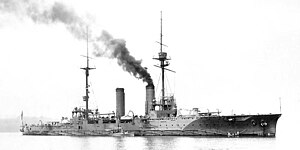 Tsukuba at anchor at Kure, after 1913
| |
| Class overview | |
|---|---|
| Name | Tsukuba |
| Builders | Kure Naval Arsenal |
| Operators | |
| Preceded by | Kasuga class |
| Succeeded by | Ibuki class |
| Built | 1905–1908 |
| In service | 1907–1922 |
| Planned | 2 |
| Completed | 2 |
| Lost | 1 |
| Scrapped | 1 |
| General characteristics | |
| Type | Armored cruiser (later reclassified as battlecruiser) |
| Displacement | 13,750 long tons (13,971 t) |
| Length | 450 ft (137.2 m) |
| Beam | 75 ft (22.9 m) |
| Draft | 26 ft (7.9 m) |
| Installed power | 20 Miyabara water-tube boilers, 20,500 ihp (15,300 kW) |
| Propulsion |
|
| Speed | 20.5 knots (38.0 km/h; 23.6 mph) |
| Complement | 820 |
| Armament |
|
| Armor |
|
The Tsukuba-class cruisers (筑波型 巡洋戦艦, Tsukuba-gata jun'yōsenkan) were a pair of large armored cruisers (Sōkō jun'yōkan) built for the Imperial Japanese Navy (IJN) in the first decade of the 20th century. Construction began during the Russo-Japanese War of 1904–05 and their design was influenced by the IJN's experiences during the war. The British development of the battlecruiser the year after Tsukuba was completed made her and her sister ship Ikoma obsolete, as they were slower and more weakly armed than the British, and later German, ships. Despite this, they were reclassified in 1912 as battlecruisers by the IJN.
Both ships played a small role in World War I as they unsuccessfully hunted for the German East Asia Squadron in late 1914. They became training ships later in the war. Tsukuba was destroyed in an accidental magazine explosion in 1917 and subsequently scrapped. Her sister was disarmed in 1922 in accordance with the terms of the Washington Naval Treaty and broken up for scrap in 1924.